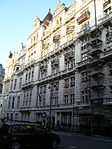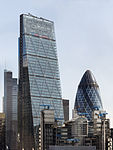Goose-Pie House
1701 establishments in EnglandBuildings and structures demolished in 1898Former houses in the City of WestminsterHouses completed in 1701John Vanbrugh buildings

Goose-Pie House was a small English Baroque house built by John Vanbrugh in Whitehall, London, in 1701. The house was demolished in 1898. The site now lies under the southeast corner of the Old War Office Building on Whitehall, near the Gurkha Memorial statue on Horse Guards Avenue.
Excerpt from the Wikipedia article Goose-Pie House (License: CC BY-SA 3.0, Authors, Images).Goose-Pie House
Whitehall Court, City of Westminster Covent Garden
Geographical coordinates (GPS) Address Nearby Places Show on map
Geographical coordinates (GPS)
| Latitude | Longitude |
|---|---|
| N 51.5052 ° | E -0.1252 ° |
Address
Whitehall Court
SW1A 2EF City of Westminster, Covent Garden
England, United Kingdom
Open on Google Maps










